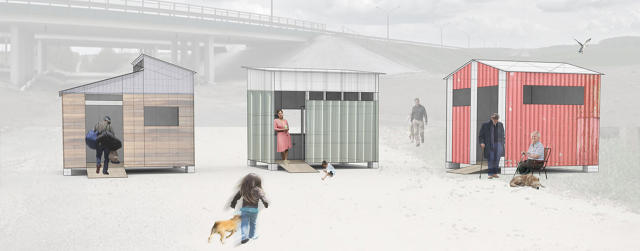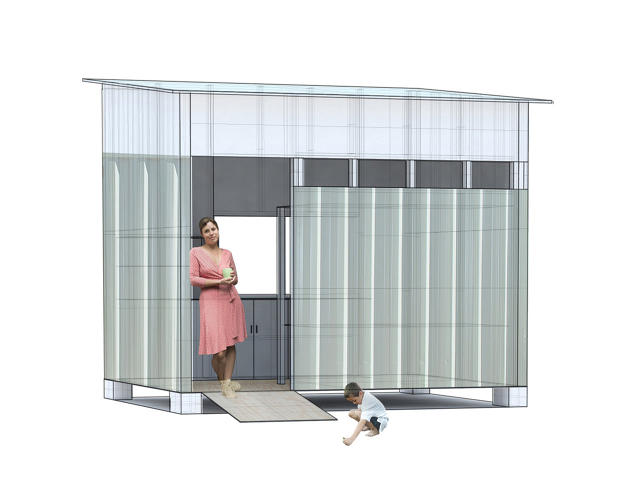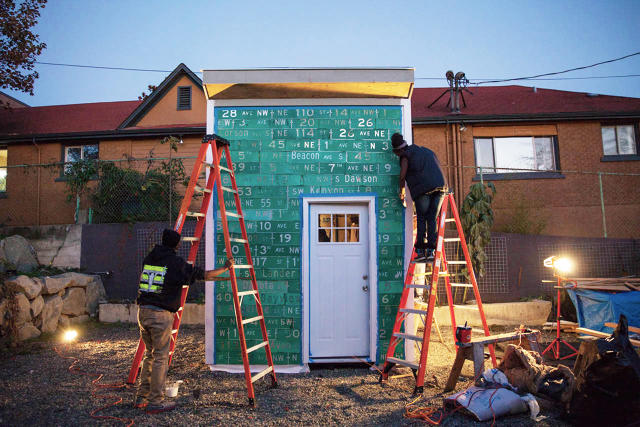In the middle of the tents, blue tarps, and simple shacks that make up Nickelsville—a homeless community in Seattle that roams from place to place wherever it can find land to use temporarily—there’s a prototype of a tiny new green house. It’s the beginning of a new, moveable “eco-village” for the community. And it was designed and built by teenagers.
Dubbed the Impossible City, the house is part of a project run by Sawhorse Revolution, a local nonprofit that teaches students basic design and construction skills while building things that the community can actually use. One day, project leaders happened to walk by Nickelsville and realized they could help.

“Basically the living conditions are tarps over tents on platforms and concrete blocks,” says program director Sarah Smith. “They do have a few shacks donated a few years ago by Home Depot, but they’re totally uninsulated, the roofs aren’t finished, and they leak and they’re starting to mold.”
The shacks were the right size and complexity for a student challenge. “There’s a need for a transportable, insulated, tiny house that provides privacy and isn’t going to be a huge burden for them when they move,” Smith says. “I was like, whoa, this is a really interesting design challenge. You go over and visit the residents, and they start telling you how cold they are at night in their shelter. Because our organization can actually do something to help, you don’t feel like you should walk on by.”
Students from the Seattle Youth Violence Prevention Initiative spent the last several months working with the homeless residents of Nickelsville, and volunteers from Olsen Kundig Architects, to design a tiny house that would be simple to move, warm, private, and meet city code. An earlier prototype, built last fall, now stands on the site.

The new home has a lofted bed with room for storage underneath, high windows for ventilation and privacy, a rubber floor that’s simple to clean, and jacks on each corner that make it easy to install on uneven ground. The team is also working on designs for a solar charging station, a community cookspace, and composting latrines.
The city hasn’t exactly embraced Nickelsville, and kicked the community off city land a couple of years ago, forcing the nonprofit that manages the group to scramble for temporary space from churches and private landowners. But for many, it seems like a necessary option as the city continues to struggle with homelessness. Ten years ago, the city adopted a 10-year plan to end homelessness; now, the rate of homelessness is actually higher.
 Sam Hunt
Sam Hunt
With shelter space in short supply, some people are forced to live on the street. And while Smith says the nonprofit doesn’t “have any illusions about the Impossible City solving homelessness,” they see it as a way to help provide a little dignity and comfort in a situation that might be inevitable, at the moment.
For students, the project has been a way to dive into a real design challenge. “They’re never really asked to do things like that in day-to-day life, design something that will actually built to serve a function in the real world, says Smith. “It’s a pretty cool responsibility.”
It also helps provide a tangible solution to a complex issue. “Because it’s so practical and hands-on, there’s a much different relationship to this social problem,” she says. “Homelessness is a really difficult thing. Everyone sees homeless people on the street, and it’s hard to know how to approach that: Why are people sleeping outside in the cold? Design allows us to ask those questions and deal with them in a really practical way.”
The project is raising funds for building supplies on Indiegogo.
[Images: via Sawhorse Revolution]